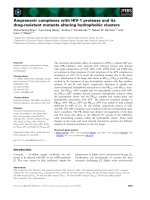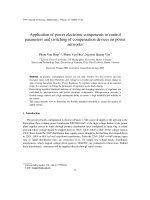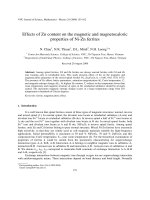Báo cáo "Application of power electronic components to control parameters and switching of compensation devices on power networks " doc
Bạn đang xem bản rút gọn của tài liệu. Xem và tải ngay bản đầy đủ của tài liệu tại đây (72.6 KB, 6 trang )
VNU Journal of Science, Mathematics - Physics 25 (2009) 77-82
77
Application of power electronic components to control
parameters and switching of compensation devices on power
networks
Pham Van Hiep
1,
*, Pham Van Hoa
2
, Nguyen Quang Viet
3
1,2
Electric Power University, 235 Hoang Quoc Viet street, Hanoi, Vietnam
3
Sience and Technology Dept, Electricity of Vietnam, 30 Ly Thai To Street, Hanoi, Vietnam
Received 19 June 2009; received in revised form 26 July 2009
Abstract. In practice, consumption devices are not only resistive but also reactive and this
reactance varies with time. Therefore, grid voltage is not stable and coefficients always change in
spite of using Automatic Reactive Power Regulator. To regulate voltage and cosφ in an expected
range, it is necessary to change the parameters of regulators as the loads change.
Determining regulated threshold and time of switching and changing parameters of regulators are
controlled by microprocessor and power electronic components. Microprocessor provides a
flexible energy control and a high automation ability to ensure a high reliability and stability of
the system.
This paper presents how to determine the flexible regulated threshold to ensure the quality of
supply energy
1. Introduction
The power network configuration is shown in Figure 1. The source of supply to the network is the
three-phase three-winding power transformer 500/220/110kV or the high-voltage busbar of the power
plant supplies power to loads through primary distribution lines configured as open ring or radial
network whose voltage should be stepped down to 35kV, 22kV, 10kV or 6kV. If the voltage rated at
35kV, there should be 35kV distribution lines supply power straight to the facilities and stepped down
to 22kV, 10kV or 6kV by local step-down transformers. From the 22kV, 10kV or 6kV primary open
ring or radial distribution lines are connected [1-3]. To supply low-voltage loads, distribution
transformers, which stepped voltage down again to 380/220V, are connected to these lines. Behind
these transformers, consumers will be supplied directly through radial circuits.
______
*
Corresponding author. Tel.: (84-4) 37554638.
E-mail:
P.V. Hiep et al. / VNU Journal of Science, Mathematics - Physics 25 (2009) 77-82
78
Fig. 1. Diagram of power network.
For this network, the power factor (cosϕ) and reactive power compensation is considered for each
voltage level. According to surveys of Power Transmission Companies and Utilities, power factor for
each voltage level as follow:
- For 35kV level: power factor is around 0.8 at peak load, 0.99 at off-peak load. Thus, the power
factors measured at sending ends of 22kV, 10kV or 6kV feeders are quite high which are similar to
those of high-voltage transmission lines.
- At receiving ends of 22kV, 10kV or 6kV feeders, measured power factors are lower than the
sending ends. Because the distribution transformers 22(10 or 6)kV/0.4kV are underload in some cases,
the power factors measured at the transformers’ secondary busbars are lower. Further, power factors
measured at terminals of appliances such as fans, air-conditioners, refrigerators, Neon tubes are even
lower because of consuming a lot of reactive power. Therefore, not only the compensation devices
should be installed on the primary side but also on the the secondary side.
Commonly, compensation level was calculated according to the loads (imposible maximum power
of loads) [4,5]. In practice, the power of loads vary depending on demand of comsumption, result in
varying voltage profile and power factor, therefore effecting power supplying quality. Further more,
reverse reactive power caused by over-compensation make power losses on the network increase.
Thus, it is necessarily to control parameters and switching compensation devices according to the
changing of loads. The controlling of compensation devices could be implemented by power
electronics structures controlling the firing angle of thyristor.
In the next section, we introduce a power electronic structure to control firing angle α of thyristor.
2. Power electronic structure for controlling firing angle α of thyristor
2.1. Controlling block diagram
The controlling circuit block diagram of thyristor shown in Figure 2.
Main functions of the circuit as follow [6,7]:
500KV
35KV
kV
6÷22kV
0,4 kV
110 kV, 220 KV
P.V. Hiep et al. / VNU Journal of Science, Mathematics - Physics 25 (2009) 77-82
79
- Flexible determining the time to issue controlling pulses in the positive half-cycles of applied
voltage to thyritor valves.
- Generate firing pulses to fire thyristor valves. The pulses have amplitudes from 2 V to 10 V
commonly, pulse width t
x
=20÷100 s for rectifiers or two parallel-connected pair of thyristor valves.
Pulse width is calculated from the formula:
dt
di
I
t
con
x
=
Where: I
con
is the continuous current of thyristor valves.
di/dt is the incremental change in load current.
Fig. 2. The block diagram of the electronic power circuit controls firing angle α.
A structure of thyristor controlling circuit comprises four main block:
- GSSPB - Generating standard sample pulse block (sensor): to issue standard sample pulse then
will be synchronized with controlling voltage signal to fire thyristor valves in need.
- Determining controlling pulses according with sample pulses CPG (Controlling Pulses
Generator): to issue controlling pulses according with sample pulses to fire thyristor valves.
- Pulse Amplifier: to amplify both sample pusles and controlling pulses to fire desired thyristor
valves.
- Isolator: to isolate the power circuit from controlling circuit.
By changing in DC voltage signal U
đk
we could change the firing angle.
2.2. Controlling principles
As illustrated in Figure 3, across controlling principle is applied to determine the time of issueing
pulse in the positive half-cycles of voltage signal applied to thyristor valves.
According to this principle [4,5], there are two voltage signals fed to comparision block:
- The input sinusoidal wave form voltage is converted to cosine wave of voltage at the output of
Generating standard pulses block.
- The controlling voltage signal is changable DC voltage.
If the sample voltage is u
sample
= U
m
sinωt than U
c
= U
m
cosωt
The firing angle α is calculated from the equation: U
m
cosα = U
control
Hence: α = arccos(U
control
/U
m
)
- If U
control
= U
m
then α = 0
- If U
control
= 0 then α =π/2
- If U
control
= -U
m
then α = π
P.V. Hiep et al. / VNU Journal of Science, Mathematics - Physics 25 (2009) 77-82
80
-
+
U2A
1
2
3
48
R1
-
+
U3A
1211
1
2
3
48
- 5V
vcc
+ 5V
-
+
U4A
1
2
3
48
Q1
R3
R22
+ 5V
- 5V
vcc
+ 5V
R05
R21
R11
Q2
R4
VR2
U1
1
2
5
4
R02
R04
- 5V
-
+
U1A
1211
1
2
3
48
PT1
T1
TRAN_HM31
1 3
2 5
C01
+ 5V
U2
1
2
5
4
R03
R01
PT2
- 5V
R12
C03
For this analysis, if we control the variation of voltage changes U
dk
from value of -U
m
to +U
m
we
could obtain the changing in firing angle α from 0 to π.
Fig. 4. Simulation circuit (measure the waveform in pulse generator controlled by the sample).
The circuit consists of two chanels for switching two thyristors Q1 and Q2. Each chanel consists of
three blocks. They are cosωt funtion generating block, comparing block and amplifier block.
- cosωt funtion generating block for two chanels consists of U1A, U3A, resistor R and capacitor C.
- comparing block for channels consists of U2A, U4A and VR2.
- amplifier block for channels consists of transistors Q1, Q2 and resistors R22, R21, R3, R05 and
U1,U2.
The circuit works based on the principle of control according to the function arccos. This circuit
uses operation amplifiers (ICs) for generating the function cosωt and comparing the signs of the inputs
of these ICs. The outputs of function generating block are fed to the positive inputs In(+) of U2A and
U4A. Their negative inputs In(-) are connected to the battery [±5V] via variable resistor VR2. The
control voltage fed IN(-) is according to adjusting variable resistor VR2. The outputs of comparing
α
ωt
U
c
U
sample
U
control
U
contr
U
U
sample
Fig. 3. Across controlling principles.
P.V. Hiep et al. / VNU Journal of Science, Mathematics - Physics 25 (2009) 77-82
81
block are fed to the base terminals of transistors Q1 and Q2 via the resistors R3 and R05 for limiting
current. The control pulses are insulated from U1 and U2 by using auto-couplers.
Some forms of pulses measured at (PT1) point at the above circuit with the different values of
U
control
are presented in the figure 5.
Pulses measured at (PT1) point when
U
control
= 0
(a)
Pulses measured at (PT1) point when
U
control
>0
(b)
Pulses measured at (PT1) point when
U
control
<0
(c)
Fig. 5. The form of pulses mesured at (PT1) point.
From the simulation, we obtain considerations: If we consider the value of voltage crossing the
zero point as the original value, we have:
- If the voltage U
control
= 0, the firing angle α = 90
0
- If the voltage U
control
< 0, the firing angle α > 90
0
- If the voltage U
control
> 0, the firing angle α < 90
0
- The construction of Pulse amplifier should be designed according with the parameters of
thyristor valves.
3. Conclusion
The application of power electronic components for controlling in the above mentioned cases
brings certain benefits. Comparing with the manual switching method or contactors switching
controlling method, determining pulse for controlling switching thyristor has some advantages. They
are not generating flashover, smooth voltage changing, not generating disturbances and harmonics.
u
A
u
C
u
A
u
C
u
A
u
C
P.V. Hiep et al. / VNU Journal of Science, Mathematics - Physics 25 (2009) 77-82
82
References
[1] Tran Dinh Long, Engergy and Electric Power Development Scheme, Science and Technology Publisher 1998. (in
Viennammese)
[2] Tran Bach, Grid & Electric Power System, Volume1, Scien and Technology Publisher, 2000, Volume1, Science and
Technology Publisher 2002. (in Viennammese)
[3] W.J Baumol, “Privatization, Competitive Entry and Rational Rules for Residual Regulation” University of Tasmania,
Department of Economics, Occasional Paper No. 2 (1997) 7.
[4] A. Estache A., M. Rossi, C. Russier, “The Case of International Coordination of Electricity Regulation: Evidence from
the Measurement of Efficiency in South America”, Journal of Regulatory Economics 25 ((2004)) 271.
[5] H. Hattori, T. Jamasb, M. Pollitt, The Performance of UK and Japanese Electricity Distribution Systems 1985-1998: A
Comparative Efficiency Analysis, Cambridge-MIT Institute Project IR-45, October 2003.
[6] S. Rungsuriyawiboon, T. Coelli, Regulatory Reform and Economic Performance in US Electricity Generation, Centre
for Efficiency and Productivity Analysis, School of Economics University of Queensland 2004; E. Thanassoulis,
Introduction to the Theory and Application of Data Envelopment Analysis, Massachusetts, Kluwer Academic
Publishers, 2001.
[7] Muhammad H.Rashid , Power Electronics Handbook (Editor in Chief), Academic Press 2001.









